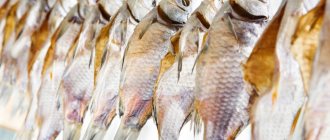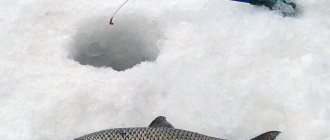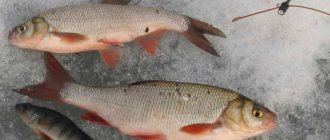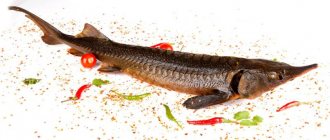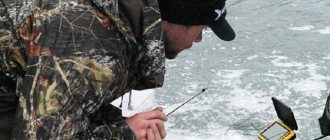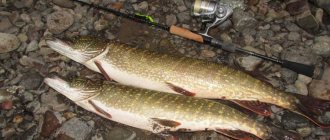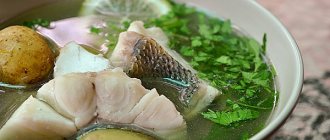Parasites are found at every step. If stored or prepared incorrectly, you can become infected with worms from fish (it doesn’t matter whether it’s white or red fish). If you have doubts about the quality of the product, it is better not to use it. If, however, consumption cannot be avoided, then you should visit a doctor as soon as possible for further examination and prescription of effective therapeutic measures.
What worms and how can you get infected from fish?
There are a wide variety of parasites in fish. What do worms look like in aquatic inhabitants? The external characteristics of parasites are varied: from size to color, and the larvae are not visible to the human eye. Before cooking, you should wash and clean the product very carefully. You can catch worms in smelt, mackerel, hake, horse mackerel, cod and other types of aquatic life. Salted, smoked, dried fish and canned fish are common sources of helminth infection. Both sea and river fish can contain a variety of helminths, namely species such as flukes, roundworms and tapeworms. Parasites are not capable of having the same negative impact on aquatic inhabitants as they do to the human body. The most common diseases include infections with opisthorchiasis, diphyllobothriasis, clonorchiasis, ligulosis, and nanophyetosis.
So, what to do with the fish?
Almost all representatives of the carp family are susceptible to infection with opisthorchiasis. Among them: roach, sabrefish, silver carp, bream, asp, rudd and others. Yasi and perch are especially often infected, but sturgeon are considered relatively safe.
Marine life is free of this parasite, with the exception of some breeds that can move from salt water to fresh environment (muksun). Northern peoples are very fond of eating this fish in its natural form, so they have a high risk of opisthorchiasis.
Predators are less susceptible to the disease, however, there are cases when flukes are found in pikes if they eat infected young carp. Moreover, opisthorchiasis is found not only in fish, but also in caviar, which must be taken into account when processing prepared raw materials.
The parasite is killed only by proper processing of fish, which can be done in different ways - salting, exposure to high and low temperatures.
Salting is carried out in a strong salt solution, which is prepared at the rate of 1 kg of salt for every 5 kg of fish, which must be laid in layers, without adding water. Before salting, the fish is carefully inspected, washed, and the entrails are removed.
How much to salt fish to kill opisthorchiasis depends on its size, for example:
- small fish – 2 weeks;
- if the length is 20-25 cm - 3 weeks;
- large specimens over 25-30 cm - at least 5 weeks.
With a small amount of fish, the cooking time is reduced in proportion to the weight and volume of the raw material; the minimum for salting is 10 - 14 days.
Opisthorchiasis dies only when hot smoked for 2 hours at a temperature of at least 80 degrees. On the contrary, cold smoking does not kill parasites, the larvae can remain viable, so this method is not suitable for river fish or requires prior freezing or salting.
This method is safe in terms of infection with opisthorchiasis, if you observe the temperature and freezing time per 1 kg of raw materials:
- at -10 degrees Celsius, fish should be kept in the freezer for a month;
- at -15 degrees, 2 weeks is enough;
- at -28 degrees it takes two days;
- at - 35 only 15 hours;
- at -40 degrees, 8 hours is enough.
Eating fresh frozen fish (stroganina) is considered dangerous; a product prepared in this way does not guarantee the destruction of larvae.
Cooking over fire or in the oven
A difficult question is how to kill opisthorchiasis, for example, in a large asp. Purchased or caught large fish must be pre-processed, cut into small pieces of 100-120 g. Boil or simmer with water under a lid for at least a third of an hour from the moment of boiling; pieces must be fried in a frying pan, turning them on all sides.
At the same time, the kitchen must have cutting boards separately for fish, meat and prepared foods. Again, you can only use a board that has been treated with cleaning solutions and washed with boiling water. How to cook fish in the oven? Pies must be baked for at least 60 minutes at a temperature of 180-200 degrees.
To reduce the risk of infection, all fishing enthusiasts need to know how to kill opisthorchiasis in fish; this serious disease is easier to prevent than to treat for it later.
How dangerous are fish worms?
Fish worms can affect all internal human organs.
What parasites are most dangerous to humans? Fish helminths have a negative impact on the entire human body and all internal systems. This is due to the types of helminths that can cause complications leading not only to surgery, but also to the death of the patient. For example, anisokida larva, when it enters the patient’s intestines, penetrates its walls with the help of incisors, which can provoke rapid hemorrhage from the intestines.
People suffering from opisthorchiasis, if it lasts for a long time, can get a chronic form of the disease, which is fraught with cirrhosis of the liver and subsequent death. In dioctophimosis, helminths mainly live in the bladder, kidney organs and ureters, which allows adult individuals to disrupt the functioning of the urinary system, thereby provoking renal colic and renal failure. This is not the entire list of dangers to humans. If you suspect consumption of worms in fish, you should consult a doctor.
Is it possible to eat fish infected with worms?
The biggest danger to humans is eating raw fish.
If the fish is infected, can it be eaten? If worms are found in frozen fish or fish meat (for example, if there is crucian carp with worms), you should pay attention to compliance with the rules during processing of such a product. If the dish is prepared according to all standards, then there is no danger to the human body. However, consumption of contaminated raw fish or those with improper preparation should be avoided. If for some reason you have eaten such a product, then antiparasitic preventive measures should be taken in the near future.
It is possible to defeat parasites!
Antiparasitic Complex® - Reliable and safe removal of parasites in 21 days!
- The composition includes only natural ingredients;
- Does not cause side effects;
- Absolutely safe;
- Protects the liver, heart, lungs, stomach, skin from parasites;
- Removes waste products of parasites from the body.
- Effectively destroys most types of helminths in 21 days.
There is now a preferential program for free packaging. Read expert opinion.
Read further:
What can you become infected with opisthorchiasis when consumed? Dangerous foods
Worms in fish: are there river or sea fish? Is it possible to eat raw or salted fish with worms?
Opisthorchiasis in cats: symptoms, drugs for treatment, can you get infected from a cat?
Opisthorchiasis in fish: which species are most often affected (list), symptoms and how not to get infected
Who is most at risk of contracting phthiriasis?
Deworming products for children: the safest and most effective methods of preventing helminthiasis
Symptoms of infestation
The first clinical picture of helminthic infestation does not appear immediately and has vague signs. Symptoms depend on the incubation periods of helminth infections, which can range from 2 to 60 days. Common symptoms of parasitic infestation include:
- lethargic, drowsy state;
- excessive fatigue;
- nervousness;
- increase in low-grade fever;
- allergic reactions;
- attacks of nausea and vomiting;
- disorders in the gastrointestinal tract;
- excessive gas formation;
- jumps in weight indicators;
- depressive state.
What to do after eating sick fish?
You should consult a doctor as soon as possible.
After eating diseased fish, you should see a doctor as soon as possible for timely diagnosis and early therapeutic measures. A mandatory point is to conduct an examination of all family members, due to the ability of many fish worms to become infected through contact. In order to avoid re-infection, careful adherence to personal hygiene rules and special dietary nutrition are a prerequisite during therapy.
How can you tell if a fish is infected with helminths?
In order to protect yourself and your family from infection with parasites from fish, you should know what an infected product looks like:
- the muscles are soft and there is no rigor; if you press on such a fish, the hole will not disappear;
- cloudy and dry mucous membrane in the pupils;
- easy separation of scales, under which sticky skin is visible;
- the fish belly looks saggy and swollen;
- marshy gills;
- the fish emits a pungent odor;
- a strongly protruding anus, from which cloudy discharge may flow.
Proper cooking of fish
Properly cooked fish does not pose any threat to human health.
Compliance with what measures can protect a person from fish worms (it doesn’t matter if they are found in capelin, crucian carp or some other type of fish)? Proper preparation and storage of fish will help avoid infection with helminthic infestations. Raw fish recipes can be prepared following these rules:
- you should use fish that have been raised under artificial conditions (artificial food, proper care and anti-parasitic control);
- seafood caught from the ocean must be frozen on board and thawed before consumption;
- river fish are mostly susceptible to worms, which pose a danger to human health (with the exception of sturgeon, they do not contain worms), as a result, they should be properly processed before consumption.
Freezing
Properly frozen fish does not have dangerous consequences for the human body. In order to disinfect fish from worms, it should be frozen; to ensure the correct procedure, the fish must be kept in the freezer for 5 days at a temperature of -20°C. However, the freezer compartment of a regular refrigerator maintains temperature ranges from 11 °C to 18 °C. Such conditions increase the storage of fish for the purpose of preventing worms by up to 2 weeks.
Heat treatment
Insufficient heat treatment is one of the common causes of parasite infection.
The cooking period for fish should be at least 20 minutes after the water has boiled. It is recommended to cut the fish carcass into large pieces for cooking. If a whole or large fish is subjected to the boiling process, then its duration must be increased. Fry each side for 10 minutes or more (depending on the portions of the product) with the lid on. When grilling, there is a possibility that the end part will not be able to reach the temperature that kills worms (over 100°C). Bake the fish for at least 40 minutes. Worms from smoked fish can also infect the human body, so special attention should be paid to the quality and appearance of the product.
Salting
Salted, dried and dried fish contain the most worms. Salting fish should be done in portions of no more than 2 kg each. The safest fish is considered to be fish that has been salted in the cold for 15-20 days in well-salted brine. The process of drying fish should be carried out for at least 21 days; after this period, dried fish is considered safe for humans.
Also, during any preparation of an aquatic product, sanitary standards should be observed, namely:
- avoid tasting raw minced meat;
- ensure that raw fish does not come into contact with other products;
- When defrosting a product, you should not leave it in the open air;
- for cutting fish there must be a separate surface and a separate knife;
- Experts recommend using gloves when working with fish.
Consumption of aquatic inhabitants with worms or the appearance of any symptoms indicating infection with parasites is not a reason to self-medicate. In such situations, you should visit a doctor as soon as possible and undergo a thorough examination of all family members. An advanced helminthic infestation (infecting all systems of the body) threatens with dangerous consequences not only for the human body, but also dangerous for his life in general. Special control should be exercised over dishes made from raw fish, as this type of food is dangerous due to helminthic infestations. Dangerous parasites in fish and their larvae are a common occurrence, but compliance with all rules and regulations during transportation and preparation of the product can protect a person’s safety.
Parasites in fish
Not everyone thinks about the dangers of fish rich in minerals and rare trace elements. Worms in fish are quite common. Scientists have identified the variety of species of worms that are transmitted to humans through fish products into a separate group and called them fish helminthiases. These diseases are insidious in that infected individuals are visually indistinguishable from healthy ones. Disappointing data from epidemiologists say that all inhabitants of freshwater bodies, as well as marine and oceanic species, are carriers of eggs and larvae of worms.
- Is herring dangerous?
- Anisokidosis
- Opisthorchiasis
- Diphyllobothriasis
- Ligulosis
- Dioctophimosis
- Ink spot disease
- Philometroidoses
- Diplostomiasis
- How to recognize infected fish
- Should I give up fish because of worms?
It is not a fact that buying seafood in a specialized store excludes infection with worms. All seafood entering store shelves undergo sanitary control. According to the standards, each carcass is checked for invasive infection (II) - the number of individuals of non-viable helminths. When this number exceeds 5, the product is discarded. Fish with an IZ of less than 5 is considered conditionally suitable, that is, after purchase it must undergo special processing.
Various types of parasites and their immature individuals can be contained in almost all parts of the body of a reservoir inhabitant. Most often, worms live in the liver, muscle tissue, skin, gills, head or belly. Certain types of parasites are found in milk and caviar bags.
Is herring dangerous?
Traditional Russian cuisine does not contain raw fish dishes. However, do not forget about herring. Due to its affordable price and unusual taste, this type of product is very popular among the masses. Of course, salting is one of the types of food disinfection. But only when technology is strictly followed. Not everyone knows that in order to completely eliminate worms from fish, you need to freeze it after catching it. Unfortunately, in their thirst for profit, unscrupulous sellers do not adhere to this. Therefore, it is quite possible to become infected with worms thanks to herring. The concentrated solution increases the resistance of parasites to aggressive environments.
Anisokidosis
The most common fish helminthiasis affecting humans is anisokidosis. This disease is caused by parasitism of anisokid larvae in the intestines. Infection occurs when eating lightly salted delicacies, in particular herring. The first alarming symptoms of infection are sudden abdominal pain, upset stool, nausea and vomiting. Often the disease imitates acute appendicitis, for which the patient ends up on the operating table. Literally biting into the intestinal wall with its incisors, the pathogen provokes intestinal bleeding. Any delay threatens the death of the infected person.
Anisokid larvae tolerate temperatures from 45 to 65 degrees Celsius. Therefore, eating smoked and dried fish will not provide complete safety with regard to parasites.
The peculiarity of the pathogen is that immediately after catching, the larvae migrate from the intestines of the fish into the muscles. Gutting and cleaning raw fish immediately after catch prevents infection.
Opisthorchiasis
Opisthorchiasis is caused by the cat fluke. The pathogen parasitizes the body of carnivores (ferrets, foxes, arctic foxes). Often carriers are dogs and cats. The intermediate hosts of the parasite are representatives of the carp family.
A person becomes infected with opisthorchiasis by eating insufficiently heat-treated or even raw fish. This disease affects the bile ducts and bladder, liver and pancreatic gland tissue. Initially, the opisthorchis larva enters the duodenum, then into the ducts of the liver, where after approximately 12 days it lays eggs. After 4 months, sexually mature worms emerge from the eggs. From this time on, symptoms of liver damage and general intoxication appear:
- headache, nausea, bitter taste in the mouth;
- heaviness and pain in the right hypochondrium;
- fever in the evening;
- fatty foods are not digested;
- Diarrhea and constipation are noted.
The chronic course of the disease is associated with the development of cirrhosis, in which irreversible destruction of liver cells occurs.
Diphyllobothriasis
The culprit of this disease is the broad tapeworm. Sometimes parasites grow up to 10-25 meters. They parasitize the body of mammals (pigs, bears, cats, dogs).
Consumption of raw water and unprocessed fish raw materials provokes infection. After 2-3 months, an adult tapeworm develops and lives in the small intestine. Clinically, diphyllobothriasis is manifested by general weakness, abdominal pain, loss of appetite, nausea, dizziness and headache. The liver and spleen are enlarged. Iron deficiency anemia often develops.
Ligulosis
The causative agent of the disease is a tapeworm, the sexually mature individual of which lives in the body of fish-eating birds. The intermediate host can be a person who has eaten infected fish from the carp family.
The parasite reaches 120 centimeters in length. By squeezing a person’s internal organs, it leads to their dysfunction. The waste products of worms are toxic; when they enter the bloodstream, they cause fever, nausea, dizziness and diarrhea.
Fish affected by this helminth have a characteristic appearance. The swollen abdomen practically does not collapse when pressed, since the parasite is located there. At the same time, the fish itself looks exhausted due to impaired metabolism by the parasite.
Dioctophimosis
One of the most dangerous fish helminthiasis, which can be contracted by drinking unboiled water and infected fish. Parasitizes inside carnivores. Dogs often get sick.
The parasite's favorite habitat is the kidneys, ureters and bladder. The eggs, entering the human body, settle in the renal pelvis, where they develop into an adult worm. By disrupting the functioning of the urinary organs, worms can lead to renal colic and contribute to the development of kidney failure. Pests can only be removed surgically. Clinical manifestations: weakness, repeated vomiting, enlarged liver, spleen, renal colic, inflammation of the urinary tract, pyelonephritis, lower back pain, blood in the urine.
Ink spot disease
Experienced fishermen always pay attention to the appearance of the caught fish. One of the manifestations of fish diseases are black spots on their body. The fishermen's concerns are not accidental. Black dots scattered on the skin, fins and mucous membranes of the eyes of fish indicate the presence of a helminth in it - the causative agent of post-diplostomiasis. The main host of this parasite is the heron, which feeds on infected fish. The worms get into it with shellfish.
The worms themselves have nothing to do with the appearance of the typical pattern in fish. It's all because of the larvae, which get into the deep layers of the skin of the inhabitants of reservoirs and form a protective capsule around themselves. A protected immature individual secretes a black dye into the surrounding tissue, which causes spotting.
In the human body, an undeveloped helminth does not cause any harm. Affected fish can be consumed with the only caveat that it has undergone sufficient heat treatment. Thorough frying and stewing of fish dishes will prevent infection by other types of worms that may simultaneously exist in the fish.
Philometroidoses
Sometimes when cleaning fish scales you can find pinkish worms curled into a ring. These are phylometroids - roundworms. The females of these parasites are located in the scales, and the males are located in the walls of the air bladder. Some individuals can reach 10–12 cm in length. Fish, eating small crustaceans - cyclops, become infected with helminths from them. These parasites are not dangerous to humans. They cause irreversible harm to the fish’s body, damaging all its internal organs.
Diplostomiasis
This fish helminthiasis is also not dangerous to humans. Living conditions in the human body are unfavorable for diplostomes.
Some trout and silver carp have cloudy eyes. This phenomenon is caused by the parasitism of small flukes by diplost in the vitreous body of the fish eye. Weakened and blind fish become easy prey for birds. The feces of infected birds end up in water bodies, where the pathogen infects plankton. The final link in the chain is fish, which become infected when they eat small shellfish.
How to recognize infected fish
In order not to purchase fish infected with worms, you should know what a product unsuitable for food looks like:
- due to the lack of muscle rigor, the fish is soft, the hole formed by pressure does not level out;
- cloudy pupils with dry mucous membranes;
- easily detachable scales with sticky skin;
- swollen and saggy abdomen;
- the gills are swampy in color, and the internal organs emit an unpleasant odor;
- Cloudy mucus flows from the protruding anus.
The broth made from such fish also has specific properties. In a cloudy broth there is no fatty film on the surface at all; instead, numerous flakes and particles float.
Should I give up fish because of worms?
Of course, there should be no taboo on eating your favorite fish dishes for fear of helminthiasis. Knowledge of the basic rules for storing and processing fish will allow you to eat it without restrictions. Worms die at temperatures above 100 degrees; when it drops below 25 degrees Celsius, the parasites also lose viability. The basic rules to prevent infection with worms are as follows:
- It is prohibited to taste fish and minced fish during the cooking process;
- When cooking, expose the fish to heat for at least 30 minutes;
- Before frying, cut large fish into layers or small pieces;
- depending on the hot or cold type of salting, soak the fish from 5 days to two weeks;
- When freezing, remember that the faster the freezing, the lower the freezing temperature should be.
You will be surprised how many parasites will come out if you drink a glass of regular...
Parasites will leave the body in 3 days! You just need to drink on an empty stomach...


